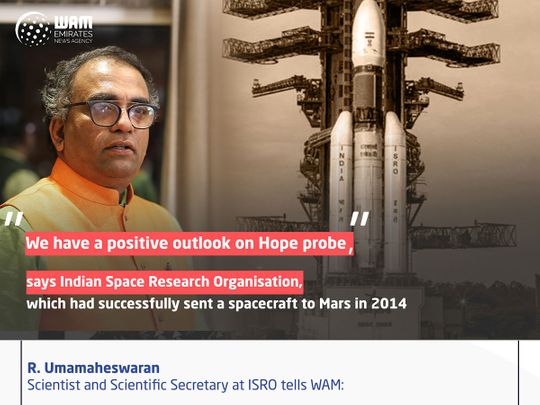
ABU DHABI: Indian Space Research Organisation (ISRO), which had successfully sent a spacecraft to Mars in 2014, has “a positive outlook” on the Hope Probe’s success, which “will expand the global team that can coordinate and jointly plan future missions to Mars.”
A senior scientist at ISRO told Emirates News Agency (WAM) on Tuesday, “It is an exciting opportunity as the UAE’s Hope mission approaches Mars for an orbit injection. The successful approach to Mars provides renewed confidence in the upcoming phases of the mission.”
R. Umamaheswaran, Distinguished Scientist and Scientific Secretary at ISRO, made these comments as the Hope Probe’s Mars orbit insertion success is expected to be determined Tuesday evening UAE time. That delicate phase will decide the success of the mission. “We have a positive outlook on Hope and wish the very best for this maiden mission from UAE to Mars,” he said in an email interview from Bengaluru.
First Asian country
India was the first Asian country and the fourth globally to join the exclusive club that have reached Mars alongside the US, Russia and the European Space Agency.
With its indigenously made unmanned spacecraft, India became the first nation in the world to successfully reach Mars on its first attempt in 2014. If the Hope Probe successfully reaches Mars, the UAE will become the fifth member of that elite club.
Asked about the significance of that achievement, the ISRO scientist said, “Future planetary exploration efforts can be more optimal with global collaborations. UAE’s successful effort will expand the global team that can coordinate and jointly plan future missions to Mars.”
Ahead of the Hope Probe’s launch in August last year, Umamaheswaran had told WAM that the mission would give crucial inputs to India’s next Mars mission and open up new avenues of cooperation between both nations.
He added on Tuesday, “Science results from this mission will be useful for planning subsequent Mars missions globally including that of India’s next Mars mission. It will also open up new avenues of cooperation globally. Once we get a chance to see the early results, we can explore such possibility.”
“I wish all success for this crucial phase of this mission and subsequent successful operations to derive scientific benefits,” said the scientist, who is also concurrently holding the post of Director of Space Science Programme Office at the ISRO Headquarters in Bengaluru.
Most dangerous part of voyage
The Hope Probe is expected to enter the orbit around Mars — the most dangerous part of its voyage, as the manoeuvre involves reversing the spacecraft and firing the Hope Probe’s six Delta-V thrusters in a 27-minute burn to rapidly slow down the speed of the spacecraft from 121,000km/h to 18,000km/h.
During this phase, Mars Orbit Insertion, contact between the probe and the operations team are kept to a minimum. If it successfully enters Martian orbit, the Hope Probe will transition to the “science phase,” and capture and transmit the first photo of Mars within a week.
At that point, it will commence its mission to build the first complete picture of the Martian atmosphere using its three advanced scientific instruments that will continue to relay data of the Red Planet’s atmosphere for one Martian year, equivalent to 687 Earth days.
The mission is expected to collect more than 1,000 GB of new data, which will be shared with over 200 academic and scientific institutions around the world.








